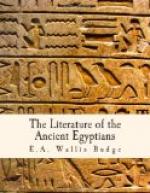When the Pyramid Texts were written men believed that the welfare of souls and spirits in the Other World could be secured by the prayers of the living. Hence we find in them numerous prayers for the dead, and hymns addressed to the gods on their behalf, and extracts from many kinds of ancient religious books. When these were recited, and offerings made both to the gods and to the dead, it was confidently believed that the souls of the dead received special consideration and help from the gods, and from all the good spirits who formed their train. These prayers are very important from many points of view, but specially so from the fact that they prove that the Egyptians who lived under the sixth dynasty attached more importance to them than to magical spells and incantations. In other words, the Egyptians had begun to reject their belief in the efficacy of magic, and to develop a belief of a more spiritual character. There were many reasons for this development, but the most important was the extraordinary growth of the influence of the religion of Osiris, which had before the close of the period of the sixth dynasty spread all over Egypt. This religion promised to all who followed it, high or low, rich or poor, a life in the world beyond the grave, after a resurrection that was made certain to them through the sufferings, death, and resurrection of Osiris, who was the incarnation of the great primeval god who created the heavens and the earth. A few extracts illustrating the general contents of the Pyramid Texts may now be given.
I. Mention has already been made of the “opening of the mouth” of the dead king: under the earliest dynasties this ceremony was performed on a statue of the king. Water was sprinkled before it, and incense was burnt, and the statue was anointed with seven kinds of unguents, and its eyes smeared with eye paint. After the statue had been washed and dressed a meal of sepulchral offerings was set before it. The essential ceremony consisted in applying to the lips of the statue a curiously shaped instrument called the PESH KEF, with which the bandages that covered the mouth of the dead king in his tomb were supposed to be cut and the mouth set free to open. In later times the Liturgy of Opening the Mouth was greatly enlarged and was called the Book of Opening the Mouth. The ceremonies were performed by the Kher-heb priest, the son of the deceased, and the priests and ministrants called Sameref, Sem, Smer, Am-as, Am-khent, and the assistants called Mesentiu. First of all incense was burnt, and the priest said, “Thou art pure,” four times. Water was then sprinkled over the statue and the priest said, “Thou art pure. Thou art pure. Thy purifications are the purifications of Horus,[1] and the purifications of Horus are thy purifications.” This formula was repeated three times, once with the name of Set,[2] once with the name of Thoth,[3] and once with the name of Sep. The priest then said, “Thou hast received thy head, and thy bones have




